Sinningia stapelioides
This species, formerly known by the holding name "Pancas", has an interesting growth habit, with (normally) just one stem and one leaf. The flowers appear in winter, usually after the stem and its one leaf have dropped.

| Species list |
Hybrids list |
Tubers list |
Topics list |
Site index |
What's new |
Home page |
Sinningia stapelioidesThis species, formerly known by the holding name "Pancas", has an interesting growth habit, with (normally) just one stem and one leaf. The flowers appear in winter, usually after the stem and its one leaf have dropped. |
|

|
|
|
This species was formerly known and distributed under the holding name S. sp. "Pancas". The official name was published in 2019. This new species has intriguing veined and spotted flowers, resembling some in the genus Stapelia (family Apocynaceae). The composite photo at the right, supplied by Alain Chautems, shows some features of the plant. The upper left picture shows the flower, with probably the most spotting of any Sinningia species. Its only real competitor is Sinningia guttata. The lower right shows the inflorescence borne directly from the tuber, when the plant is leafless. In this it resembles Sinningia defoliata. The tuber appears to be imbedded in a rock crevice. The upper right shows the habitat of this plant. It grows on an inselberg, literally "island mountain" in German, referring to a large rocky protuberance jutting above the surrounding terrain. Presumably, possession of a tuber enables the plant to survive in this inhospitable-looking environment. |
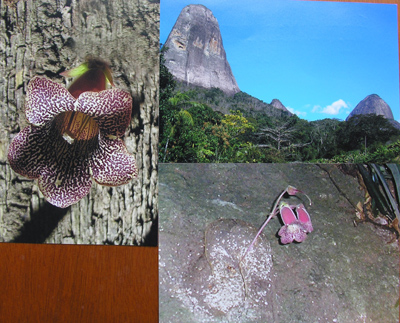
|
Growth And Habit |
|
|
This species has stems that resemble petioles (leafstalks) because they grow directly from the tuber and bear (usually) one leaf. |
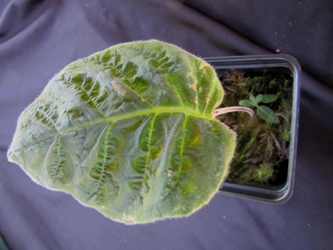
|
|
Sometimes the plant bears two leaves on the same stem, demonstrating that the stem is not a leafstalk. |
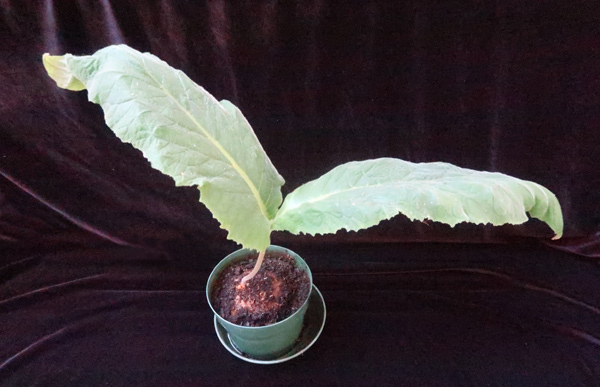
|
|
|
|
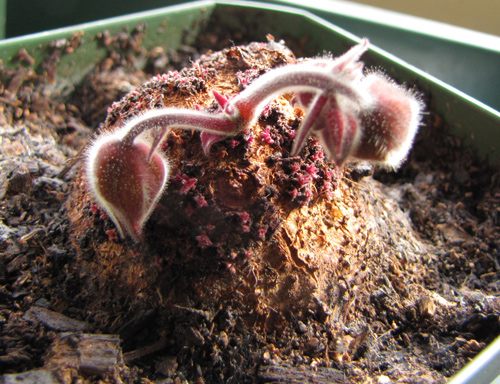
|
First flowerI sowed the seed of this species in August 2010. In November 2014, I saw the first flowerbuds. This picture shows the tuber in December 2014. In addition to the developing flowerbuds, one can see the shoot buds scattered along the surface of the tuber. This strongly resembles the appearance of the Sinningia helioana tuber. This provides one piece of evidence that the two species are closely related. The flowers of both species are held almost vertically. In nature, as suggested by Alain Chautems's picture above, the tuber may grow at an angle, with the flowers pointing downslope. |
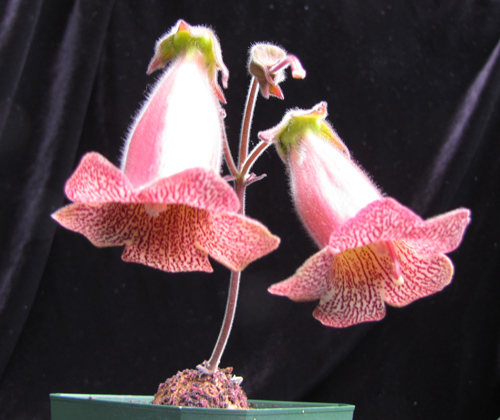
|
Unfortunately, the first corolla dropped without ever opening. The second dropped almost as soon as it opened. I set the base of the corolla in a pan of water, in hopes that the pollen would ripen. The corolla opened further, and lasted a couple of weeks. The plant had two more buds, however, and both of them opened without dropping. These corollas are about 6 cm [2.3 inches] long and almost 5 cm [2 inches] across the face. This species has the standard gesneriad pair-flowered cyme. The first flower on this cyme is represented by the style at the top. This is the remnant of the flower that opened and immediately dropped. The flower on the right is the pair flower, positioned right under the first flower. The flower on the left is the first cyme side-branch flower (and the only one on this inflorescence). (The flower on the right dropped less than an hour after this picture was taken. Moving the plant for photography might have caused it.) |
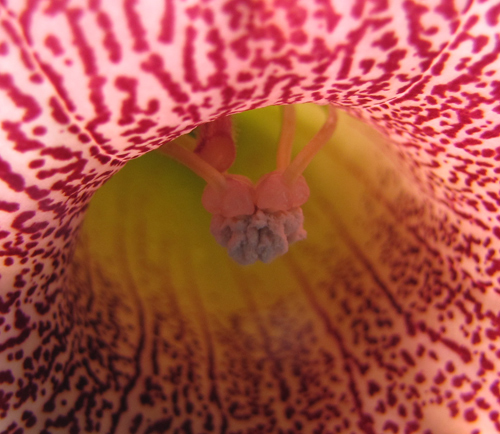
|
This picture shows a close-up of the contorted anthers. The corolla's heavy striping and speckling, and its sturdy texture suggest that this species might be bat pollinated. |

|
This picture shows a close-up of the stigma, already dusted with pollen. The flower is in its second, "female" phase. |

|
Flower cut open to show interior. Note the stamens attached to the base of the corolla tube. That is standard for stamens in the Gesneriad family. Sinningias normally have four stamens, as here. The anthers are combined into a clump, near the top of the tube. A couple of blobs of pollen can be seen adhering to the corolla tube. The pistil is not seen in this picture because it is not attached to the corolla tube but to the ovary, which is attached to the pedicel (flowerstalk). |
|
|
|

|
Fruit
This species has a fat red fruit. |
|
|
|
BudsThese are the flowerbuds of Sinningia stapelioides. They remain close to the tuber until ready to open. Initially, the corolla is completely enclosed by the red calyx, until the corolla forces its way out (as seen at upper right). Photographed November 2019. |

|
Seedlings |
|

|
This picture shows some seedlings of Sinningia stapelioides in a 3.5-inch pot. Note the light-colored midrib and herringbone side ribs, which are reminiscent of Sinningia reitzii. The latter species usually loses this highlighted rib coloration as it ages, and so, apparently, does this species, as we will see below. There are two horticultural issues to note. First is the moss growing on the surface of the soil. I rarely get moss in my pots, but all pots of this species have it. The other thing to notice is the plastic bag. I have been growing seedlings enclosed since the first few transplants, grown in the open, died. The bag is not one of the zipper types. I have another pot growing in a zipper bag, and those seedlings are quite a bit smaller, perhaps because the greater thickness of the plastic blocks too much light. Seed for these plants was sown in August 2010, and this picture was taken six months later in February 2011. |
Variety in Older Seedlings |
||

|
This picture shows a single-stem seedling. This plant still looks like it could be Sinningia reitzii. Seed sown 5 August 2010. Picture taken 6 June 2011. |
|

|
This plant has multiple stems but otherwise resembles the one above. Seed sown 10 February 2010. Picture taken 6 June 2011. |
|

|
This plant has ceased to resemble Sinningia reitzii, and now reminds us of Sinningia helioana. A single leaf is borne at the top of a stem which looks like a petiole. Note the moss around the base of the stem, and the new shoot with normal sinningia growth habit. Seed sown 5 August 2010. Picture taken 6 June 2011. |
|

|
This unusual form combines the ones above. It has a normal shoot growing out of the node at the top of a "unifoliate", helioana-like shoot. See the picture at the right for the whole plant. Seed sown 22 February 2010. Picture taken 6 June 2011. |
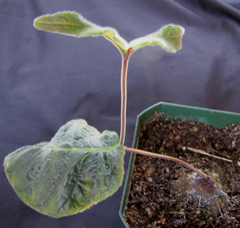
|
|
|
||
The variety dwindlesAs the plants aged another year, the plants obviously acquired the same pattern: one leaf on a petiole-like stem. The differences in size are probably due to culture. The plant at the far right was growing outdoors. None of the plants bloomed until one did near the end of 2014. |

|
|
Sinningia stapelioides leaves last a long time (years) when dried, without any special arrangements at all (no press, no desiccant), See here for a picture. |
|
|
|
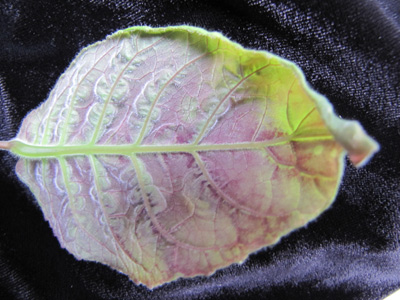
|
Leaf BackHere we can see the back of the leaf, with a tinge of maroon, contrasting with the puckers of green along the ribs. The younger seedlings in the picture above have solid maroon leafbacks, another characteristic shared with S. reitzii. |
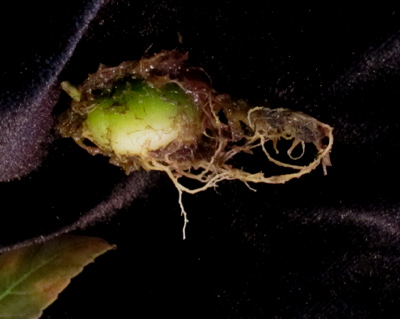
|
TuberThe ball-shaped tuber of this species is often green, even in areas not exposed to light. Small tubers (less than 1 cm in diameter) are green spheres. Note that most of the roots on this tuber sprout from the top, rather than the underside. |

|
This ten-year-old tuber, photographed in April 2020. is a very flattened ball, with almost no roots. The plant has been growing outdoors, At this point, it gave no sign of reviving for another year of growth. |
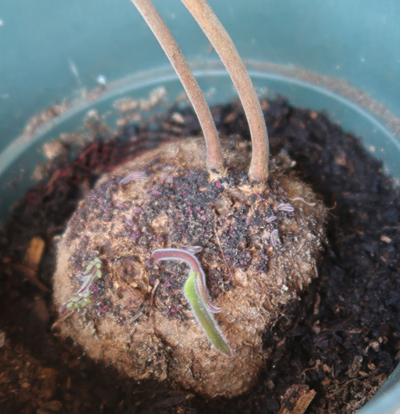
|
This is the same plant, photographed about seven weeks later. A new stem, flattened against the tuber, is developing, with its one new leaf. The two persistent stems from 2019 can be seen at the top of the picture. |
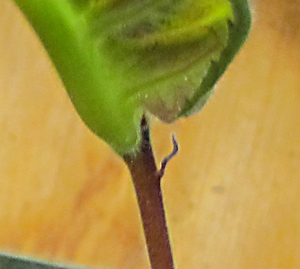
|
Leaf stub -- or Stem, not PetioleAs in the case of S. helioana, we can discover that what appears to be a petiole is actually a stem. This is shown by the dried leaf stub just below the blade of the main leaf. From the surface of the stalk, one cannot see where the boundary between the stem and the petiole is, but the presence of the leaf stub almost certainly indicates that all the "stalk" tissue above it is actually petiole and the tissue below it is stem. |
|
This stem, with two leaves, is clearly not a petiole. Here, the larger of the two leaves is about 32 cm [12.5 in] long. Pot diameter is 5 inches [12.5 cm]. This plant is grown outdoors, in full shade (so far). It has not bloomed (as of 2018, when this picture was taken). |
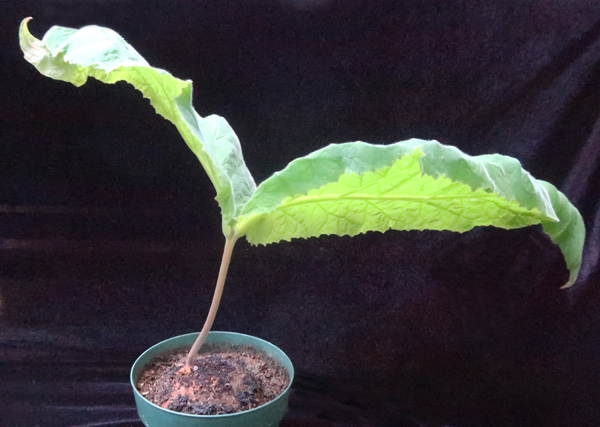
|
| Plant Description |
|
| Growth | Indeterminate as juvenile, determinate when older. |
| Habit | When juvenile, low herb with compressed stems. When older, one leaf on stalk. |
| Leaves | Patterned when young. Backs solid maroon when young, mottled maroon or plain green when older. |
| Dormancy | Plant has a tuber. Strictly speaking, my plants do not have a dormant period unless they do not bloom. Blooming (or not blooming) alternates with vegetative growth. |
Flowering |
|
| Inflorescence | axillary cyme growing directly from tuber. |
| Season | Winter. It may require short days to bloom. |
| Flower | Spotted; see pictures at top of page. |
Horticultural aspects |
|
| Hardiness | So far, a seedling has survived 32 F [0 C] nights outdoors. Given where it was found, I expect it to be relatively tolerant of cold. The outdoor plants have not bloomed, however. |
| Culture | Appears to appreciate high humidity.
Seedlings grow very slowly. (This may be due to my incorrect growing conditions.) |
| Seed to bloom | For me, it took four years. And that was only one of my plants. |
Botany |
|
| Taxonomic group | Apparently in the aghensis group of the Corytholoma clade. Its closest relative is probably Sinningia helioana. |